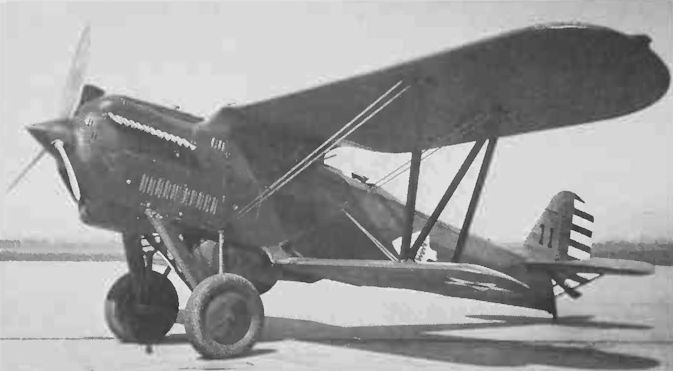Berliner-Joyce P-16 и PB-1
Первым самолетом фирмы "Berliner-Joyce", запущенным в серийное производство, стал двухместный истребитель, спроектированный согласно требованиям Авиационного корпуса Армии США. Прототип Berliner-Joyce XP-16 впервые поднялся в воздух в октябре 1929 года. Самолет имел металлическую конструкцию с преимущественно полотняной обшивкой. Верхнее крыло бипланной коробки - по типу "чайка". Изначально самолет был оснащен V-образным двигателем Curtiss V-1570-A мощностью 600 л. с.
По результатам испытаний было заключено два контракта на серийное производство 15 и 10 самолетов, получивших обозначение Y1P-16 и предназначавшихся для войсковых испытаний. Поставленные в 1932 году, они почти не отличались от прототипа, но оснащались двигателями V-1570-25. После испытаний самолет был принят на вооружение под обозначением P-16, но позже его изменили на PB-1 (Pursuit Biplane). Эксплуатация выявила недостаточные скоростные и маневренные качества истребителя, а также тенденцию к капотированию на посадке, из-за чего уже в январе 1934 года самолет был снят с вооружения.
ТАКТИКО-ТЕХНИЧЕСКИЕ ХАРАКТЕРИСТИКИ
Berliner-Joyce P-16 (PB-1)
Тип: двухместный истребитель
Силовая установка: один V-образный двигатель Curtiss V-1570-25 мощностью 600 л. с. (447 кВт)
Характеристики: максимальная скорость на уровне моря 282 км/ч; крейсерская скорость на оптимальной высоте 243 км/ч; начальная скороподъемность 600 м/мин; время набора высоты 4570 м - 8 мин 48 с; практический потолок 8840 м; дальность 1046 км
Масса: пустого 1271; максимальная взлетная 1813 кг
Размеры: размах крыла 10,36 м; длина 8,59 м; высота 2,74 м; площадь крыла 25,92 м
Вооружение: два фиксированных стреляющих вперед 7,62-мм пулемета в носовой части фюзеляжа и один 7,62-мм пулемет на турели в задней кабине; до 111 кг бомб на внешней подвеске
Показать полностьюShow all
Flight, March 1934
The B/J P-16
THE P-16, which is the standard two-seater fighter of the U.S. Army Air Corps, is of all-metal construction, the chief materials used being chrome molybdenum steel and duralumin. Practically any liquid or air-cooled engine from 500-800 h.p. may be used, the machines supplied to the U.S. Army Air Force, being fitted with the Prestone cooled Curtiss "Conqueror," type SV-1570, which gives 600 h.p. at 2,400 r.p.m. In a modified version of the P-16 the Wright "Cyclone" (700 h.p.) or the Pratt & Whitney ''Hornet'' (600 h.p.) may be used. The aircraft has been designed for the latest U.S. "Pursuit" load factors, including diving requirements.
The wings are of all-metal construction, the spars being built up with flanges of extruded sections with "wandering webs," both the flanges and webs being of duralumin. The drag system is composed of duralumin tubular compression ribs with diagonal bracing of swaged steel wires. Ailerons, which are of the Frise "skew" type, are fitted to the upper planes only. The fuselage is a rectangular structure of the welded chrome molybdenum steel truss type, covered with fabric. Chrome molybdenum steel is also used for the engine mounting, which is detachable at four points on the fuselage.
The cockpits may be of either the open type or may be fitted with a cabin top to protect the pilot and gunner from the air stream. This cabin top adds approximately 5 m.p.h. to the top speed and 50 lb. to the weight. The undercarriage of the original P-16 was of the conventional "split" type, but in the latest machine this has been replaced by a cleaner and simpler structure.
The main fuel tank holds 85 gall., and is carried in the fuselage, but an auxiliary "droppable" tank of 75 gall, capacity may be carried below the fuselage, bringing the fuel supply up to 160 gall. Provision is made for the installation of two fixed Browning guns in the fuselage and a movable gun over the rear cockpit. The front guns may be either both of 0.30 calibre or one 0.30 calibre and one 0.50 calibre. For the 0.30 gun 1,000 rounds are provided, but for the larger calibre weapon only 150 rounds are carried. The rear gun is provided with 800 rounds. Although a two-seater fighter, the aircraft can carry up to 500 lb. of bombs.
When fitted to the Wright "Cyclone" of 700 h.p., it is expected that a speed of 212 m.p.h. at 15,000 ft. will be attained. Both the service ceiling and absolute ceiling, however, will probably be less.
THE B/J P-16 (MODIFIED) (P-127)
Length 28 ft. 10 in.
Height 9 ft. 9 in.
Span (upper) 34 ft.
Span (lower) 23 ft. 4 in.
Chord (upper) 72 in.
Chord (lower) 48 in.
Gap 58 ft. 9 in.
Wing area (including ailerons) 250 sq. ft.
Weight empty 3,109 lb.
Disposable load 1,192 lb.
Gross weight 4,209 lb.
Performance (estimated)
Speed at sea level 170 m.p.h.
Speed at 5,000 ft 183 m.p.h.
Speed at 12,000 ft 200 m.p.h.
Speed at 15,000 ft 192 m.ph.
Speed at 20,000 ft 178 m.p.h.
Cruising speed at 12,000 ft. 162 m.p.h.
Climb to 5,000 ft 2-9 min.
Climb to 12,000 ft 6-9 min.
Climb to 15,000 ft 8-8 min.
Endurance at full throttle (normal) l-6 hr.
Endurance at full throttle (overload) 3-02 hr.
Range at full throttle (normal) 323 miles.
Range at full throttle (overload) 605 miles.
Range at cruising speed (normal) 421 miles.
Range at cruising speed (overload) 785 miles.
Service ceiling 29,000 ft.
Absolute ceiling 30,000 ft.
Показать полностьюShow all



